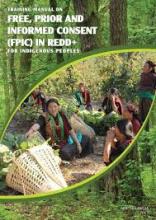/ library resources
Showing items 1 through 9 of 46.This handbook contains basic information needed by indigenous peoples to be able to exercise their right to FPIC in the face of mining activities affecting their communities.
This manual aims to build the capacities of the indigenous peoples, networks and organizations to advocate and work for the effective implementation of FPIC for indigenous peoples in the activities and projects relating to REDD+.
Wild edible plants (WEPs) can provide diverse and nutrient-rich food sources that contribute to the health and well-being of communities worldwide. In northwestern Kenya, WEPs are vital dietary components for nomadic pastoral communities with limited access to diverse cultivated food crops.
Local communities currently have limited access to information and the diversity of planting materials that would allow them to diversify their production systems to cope with unpredictable weather and stabilize their livelihoods.
This guidebook explains how to develop and implement the Climate-Smart Map and Adaptation Plan (CS-MAP). Using participatory tools, CS-MAP serves as a guide for local communities to develop their own risk maps and adaptive plans, which cater to their respective local contexts.
"This report summarizes preliminary results from fieldwork research conducted in Kenya between September and October 2022.
Despite the progress made in conceptualizing and advocating for secure community-based land and forest tenure rights, there is a critical lacuna in advocacy and policymaking processes pertaining to community-based freshwater tenure rights.
Arbajahan Ward, located within the arid landscape of Wajir West, Wajir County, is home to a resilient pastoral community heavily reliant on rangelands for sustenance.
Background: Understanding how local communities perceive threats and management options of wild edible plants (WEPs) is essential in developing their conservation strategies and action plans.
Pagination
Land Library Search
Through our robust search engine, you can search for any item of the over 73,000 highly curated resources in the Land Library.
If you would like to find an overview of what is possible, feel free to peruse the Search Guide.


